D1054
Dihydrorhodamine 123
≥95% purity, powder
Synonyme(s) :
DHR 123; Methyl 2-(3,6-diamino-9H-xanthen-9-yl)benzoate; Benzoic acid, 2-(3,6-diamino-9H-xanthen-9-yl)-, methyl ester
About This Item
Produits recommandés
product name
Dihydrorhodamine 123, ≥95%
Niveau de qualité
Pureté
≥95%
Forme
powder
Couleur
pink
Solubilité
DMSO: >5 mg/mL
Application(s)
diagnostic assay manufacturing
hematology
histology
Température de stockage
−20°C
Chaîne SMILES
COC(=O)c1ccccc1C2c3ccc(N)cc3Oc4cc(N)ccc24
InChI
1S/C21H18N2O3/c1-25-21(24)15-5-3-2-4-14(15)20-16-8-6-12(22)10-18(16)26-19-11-13(23)7-9-17(19)20/h2-11,20H,22-23H2,1H3
Clé InChI
FNEZBBILNYNQGC-UHFFFAOYSA-N
Vous recherchez des produits similaires ? Visite Guide de comparaison des produits
Catégories apparentées
Description générale
Application
Actions biochimiques/physiologiques
Substrats
Code de la classe de stockage
11 - Combustible Solids
Classe de danger pour l'eau (WGK)
WGK 3
Point d'éclair (°F)
Not applicable
Point d'éclair (°C)
Not applicable
Équipement de protection individuelle
Eyeshields, Gloves, type N95 (US)
Choose from one of the most recent versions:
Certificats d'analyse (COA)
Don't see the Right Version?
If you require a particular version, you can look up a specific certificate by the Lot or Batch number.
Déjà en possession de ce produit ?
Retrouvez la documentation relative aux produits que vous avez récemment achetés dans la Bibliothèque de documents.
Les clients ont également consulté
Articles
Cellular oxidative stress is countered by enzymatic scavengers and antioxidant modulators against reactive oxygen species damage.
Notre équipe de scientifiques dispose d'une expérience dans tous les secteurs de la recherche, notamment en sciences de la vie, science des matériaux, synthèse chimique, chromatographie, analyse et dans de nombreux autres domaines..
Contacter notre Service technique










